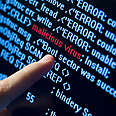
Illustration
צילום: shuttershock
Powerful cyber weapon found in Middle East
Third major cyber weapon dubbed 'flame' uncovered inside thousands of computers across Middle East; lab research shows largest number of infected machines in Iran, Israel
Security experts have discovered a new data-stealing virus dubbed Flame they say has lurked inside thousands of computers across the Middle East for as long as five years as part of a sophisticated cyber warfare campaign.
It is the most complex piece of malicious software discovered to date, said Kaspersky Lab security senior researcher Roel Schouwenberg, whose company discovered the virus. The results of the Lab's work were made available on Monday. Schouwenberg said he did not know who built Flame.
Related stories:
- Iran's Oil Ministry forms cyber crisis center Report: Iranian government websites under cyber attack 'Stuxnet implanted in Iran nuke plant with memory stick'
If the Lab's analysis is correct, Flame could be the third major cyber weapon uncovered after the Stuxnet virus that attacked Iran's nuclear program in 2010, and its data-stealing cousin Duqu, named after the Star Wars villain.
The discovery by one of the world's largest makers of anti-virus software will likely fuel speculation that nations have already secretly deployed other cyber weapons.
"If Flame went on undiscovered for five years, the only logical conclusion is that there are other operations ongoing that we don't know about," Schouwenberg said in an interview.
The Moscow-based company is controlled by Russian malware researcher Eugene Kaspersky, and gained notoriety in cyber weapons research after solving several mysteries surrounding Stuxnet and Duqu.
Researchers at Kaspersky said they were only starting to understand how Flame works because it is so complex. The full significance will not be known until other cyber security firms obtain samples of Flame.
The Lab's research shows the largest number of infected machines is in Iran, followed by Israel, then Sudan and Syria.
Complex virus
The virus contains about 20 times as much code as Stuxnet, which attacked an Iranian uranium enrichment facility, causing centrifuges to fail. It has about 100 times as much code as a typical virus designed to steal financial information, Schouwenberg said.Flame can gather data files, remotely change settings on computers, turn on PC microphones to record conversations, take screen shots and log instant messaging chats.
He said there was evidence to suggest the code was commissioned by the same nation or nations that were behind Stuxnet and Duqu, which were built on a common platform.
Both Flame and Stuxnet appear to infect machines by exploiting the same flaw in the Windows operating system and employ a similar way of spreading.
That means the teams that built Stuxnet and Duqu might have had access to the same technology as the team that built Flame, he said.
Schouwenberg said he believed the attack was highly targeted, aimed mainly at businesses and academic institutions.
He estimated that no more than 5,000 personal computers around the world have been infected, including a handful in North America.
Kaspersky Lab discovered Flame while investigating reports that a virus dubbed Wiper was attacking computers in Iran.
The International Telecommunications Union, a UN agency that promotes research and cooperation on telecommunications technology, asked Kaspersky Lab to investigate those reports.
Schouwenberg said that his team discovered Flame, but failed to turn up anything that resembled Wiper.
- Receive Ynetnews updates directly to your desktop










